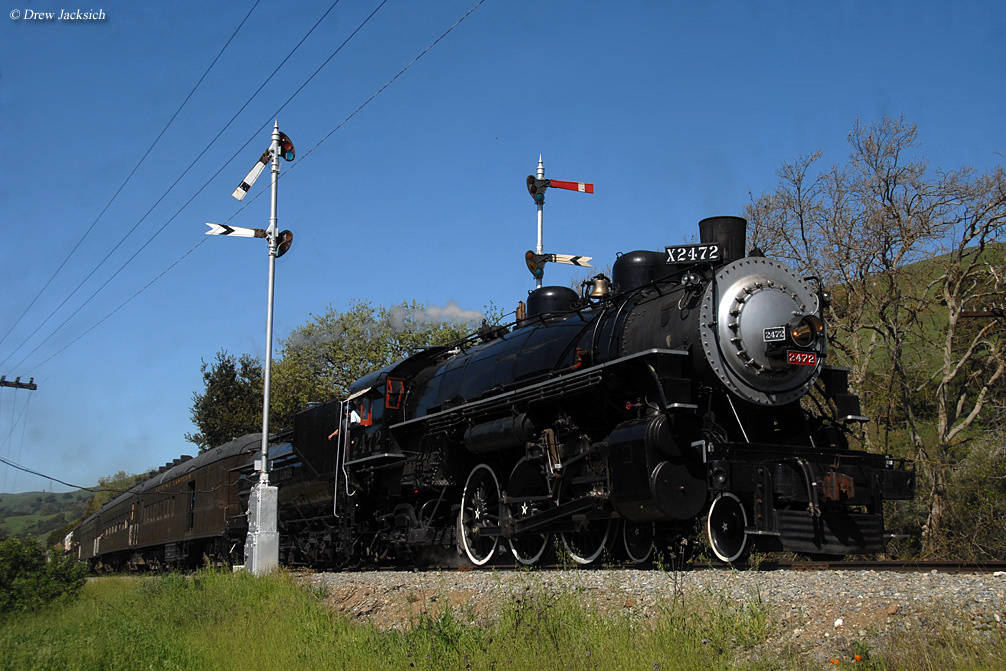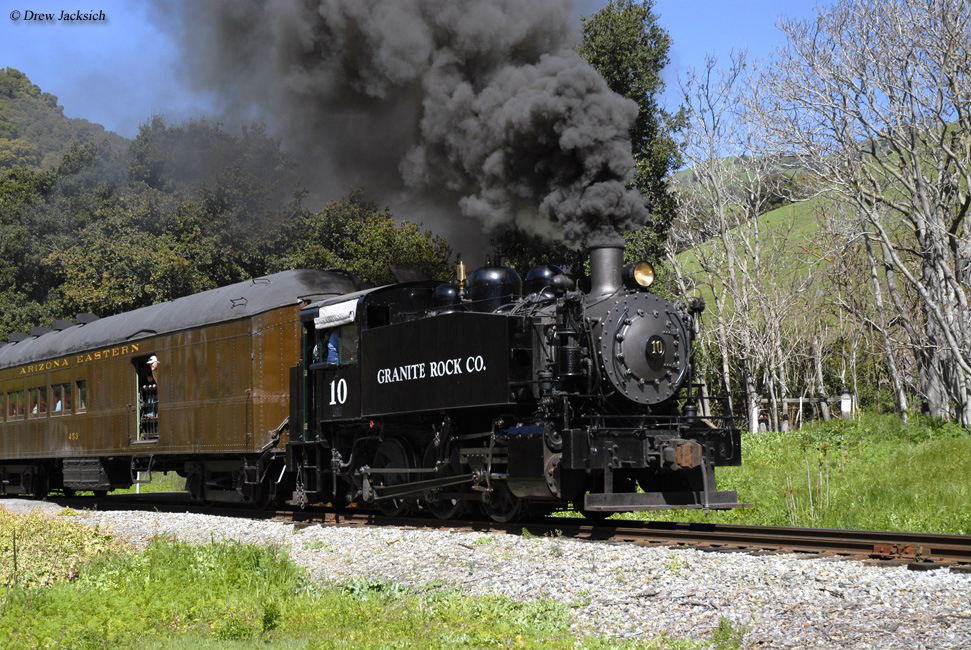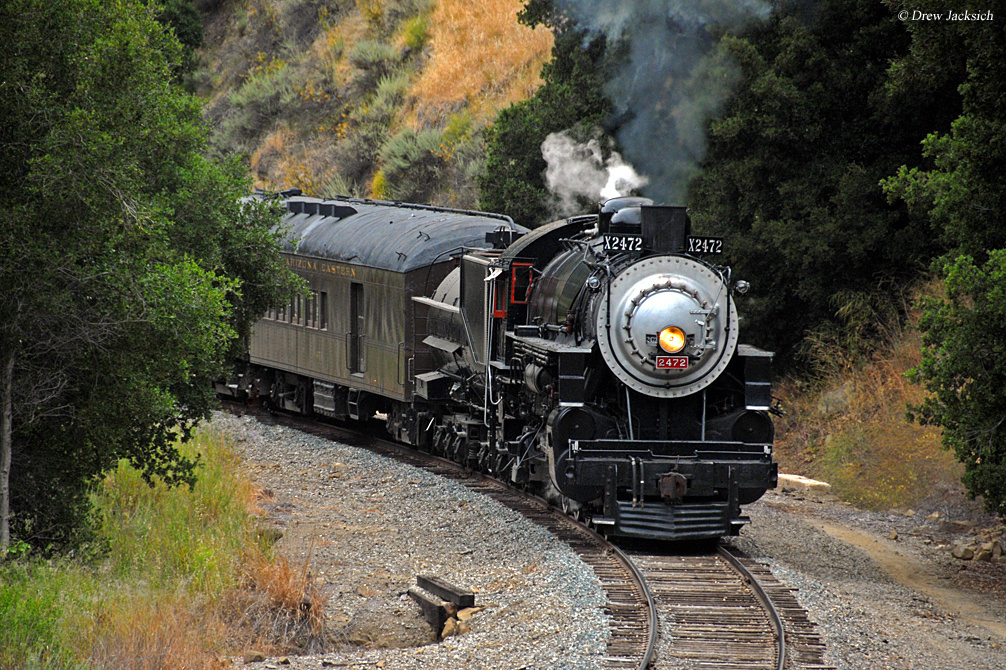Journey Into History At The Niles Canyon Railway
Last revised: September 11, 2024
By: Adam Burns
The Niles Canyon Railway is one of California's many tourist lines providing excursions to the public on a former Southern Pacific (SP) route in Alameda County that extends a little under 10 miles.
The history of the corridor can be traced back to the days of the Civil War. The SP discontinued service in the mid-1980s and subsequently abandoned the line.
However, thanks to the hard work of many volunteers a section was rebuilt a few years later and today provides a popular tourist attraction for thousands.
Today, the railroad has grown to the point that it now offers trains pulled by steam locomotives with several specials hosted throughout the year.
Photos
History
The history of the Niles Canyon Railway's route is quite historic, tracing its roots back to the completion of the Transcontinental Railroad.
That famous event concluded on May 10, 1869 with the celebrated "Golden Spike Ceremony" held to commemorate the completion of the Central Pacific and Union Pacific railroads at Promontory Summit, Utah.
While this event is well-known there was still more work to be done, namely the Central Pacific's efforts to finally complete the link to the San Francisco Bay. This project was delayed by rugged terrain, notably the Alameda Creek and Niles Canyons.
An old CPRR subsidiary, the Western Pacific Railroad Company, had been working to open a route to the bay since 1862 and was finally able to do so by September of 1869.
Following the completion of the Transcontinental Railroad it was not long before the CPRR became a subsidiary of the growing Southern Pacific system when the latter leased the former on April 1, 1885.
Both railroads were under common ownership and the CPRR slowly faded from history after this time (although, as a corporation, it survived on paper until June 30, 1959).
Under SP control the route was operated as a main line to the San Francisco Bay until subsidiary Central Pacific completed a low-grade via Benicia in 1879.
The Niles Canyon line, while more circuitous and steep, eventually settled into the role of "relief valve" for freights out of and into the Bay Area.
Route
As rail service declined sharply in the postwar years the Niles Canyon route saw increasingly less use. Eventually, a financially ailing SP and declining freight traffic within the San Francisco Bay Area led the railroad to abandon the line in 1984, deeding the right-of-way to Alameda County.
In a rather rare event related to railroad abandonment part of the right-of-way sat empty for only a few years.
In 1987 the Pacific Locomotive Association (PLA) entered into an agreement with the county allowing for rails to be re-laid on a section of the corridor, a project completed about a year later. Today, just over 9 miles of trackage has been returned to service between Pleasanton and Niles/Fremont via Sunol.
Steam Locomotives
Clover Valley Lumber 2-6-6-2T #4 (Operational. Originally built by the Baldwin Locomotive Works in 1924.)
Pickering Lumber Company 86-Ton, 3-Truck Heisler #5 (Future Restoration. Built by the Heisler Locomotive Works in 1913.)
Pickering Lumber Company 75-Ton, 3-Truck Shay #12 (Operational. Built by the Lima Locomotive Works in 1903.)
Robert Dollar Company 2-6-2T #3 (Operational. Originally built by the American Locomotive Company in 1927 for the Walter A. Woodard Lumber Company of Cottage Grove, Oregon.)
Quincy Railroad 2-6-2T #2 (Operational. Built by the American Locomotive Company in 1924.)
Sierra Railroad 2-6-2 #30 (Future restoration. Built by the Baldwin Locomotive Works in 1922.)
Southern Pacific Class S-12 0-6-0 #1269 (Built by SP's Sacramento Shops in 1921.)
Southern Pacific Class P-8 4-6-2 #2472 (Operational. Originally built by the Baldwin Locomotive Works in 1921. Owned by the Golden State Railroad Museum.)
Diesel Locomotives
Oakland Terminal Railway DS-4-4-1000 #101 (Stored serviceable. Originally built by Baldwin in 1948.)
Niles Canyon Railway 10-Ton Switcher #103 (Originally built by the Plymouth Locomotive Works for the Santa Catalina Island Company as #103 in November of 1929.)
Santa Fe 44-Ton Switcher #462 (Originally built by General Electric in July of 1943 as AT&SF #462.)
Southern Pacific ML-4000 #9010 (Under restoration. A rare, diesel-hydraulic design it was originally built by Germany's Krauss-Maffei in 1964. Significant restoration work has largely seen it returned to original appearance. The only of its kind still in existence. The group hopes to one day have it operational.)
Southern Pacific S6 #1218 (Originally built by the American Locomotive Company as Southern Pacific #1251 in 1955.)
Southern Pacific NW2 #1423 (Operational. Originally built by Electro-Motive in 1949.)
Southern Pacific GP9 #5623 (Operational. Originally built by Electro-Motive in 1955.)
Southern Pacific SD9 #5472 (Operational. Originally built by Electro-Motive in 1956.)
U.S. Army H12-44 #1856 (Originally built by Fairbanks-Morse as U.S. Army #1856 in 1953.)
U.S. Army 65-Ton Switcher #7348 (Operational. Originally built by General Electric in 1942.)
U.S. Navy 80-Ton Switcher #298 (Operational. Originally built by General Electric in 1943.)
Western Pacific GP7 #713 (Operational. Originally built by Electro-Motive in 1953.)
Western Pacific F7A #918-D (Operational. Originally built by Electro-Motive in 1950.)
Other Pieces
In addition to the route's history, where engineering projects built by the original CPRR can still be seen (such as culverts), the Niles Canyon Railway also features a beautifully restored SP depot constructed in 1884 at Sunol.
The building, architecturally, is the last of its type, designed in the railroad's "Number 7" format. Inside you can see displays while the freight room is used for meetings. Of course, for all of the route's history most folks come for the trains.
Since its inception, the PLA has amassed an impressive collection; more than half-dozen steam locomotives, four of which are operational and more under restoration (including rare Clover Valley Lumber 2-6-6-2T Mallet #4), and even more diesels of various heritage.
Current Operations
In addition to all of their motive power the group also owns an impressive list of rolling stock, which they are slowly working to restore.
This cars range from cabooses and early, outside-braced wooden boxcars, to Railway Post Office cars (RPOs), diners, coaches, and much more. They host excursions throughout the year thanks to the region's mild climate.
However, their most popular trips are normally during the holidays such as the Train of Lights for Christmas, fall specials, Valentine's Day Special, and spring events among others. To learn more about dates and scheduling please visit their website.
Recent Articles
-
Rio Grande 2-8-2 Locomotives (K-37): Specs, Roster, Photos
Apr 15, 25 12:57 PM
Rio Grande's Class K-37 Mikes were itsdge steamers to enter service in the late 1920s. Today, all but two survive. -
Rio Grande 2-8-2 Locomotives (K-36): Specs, Roster, Photos
Apr 15, 25 11:09 AM
The Rio Grande's K-36 2-8-2s were its last new Mikados purchased for narrow-gauge use. Today, all but one survives. -
Rio Grande 2-8-2 Locomotives (Class K-28): Specs, Roster, Photos
Apr 14, 25 10:24 PM
Rio Grande's Class K-28 Mikados were its newest narrow-gauge steam locomotives since the Mudhens of the early 1900s. Today, three survive.





